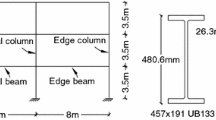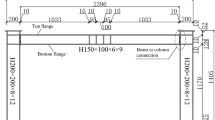Abstract
Ambiguities in current fire design codes have triggered conflicting responses from researchers and professionals about steel buildings in fire. This is because fire codes do not consider the integrated structure of the building, but are based on the tests and models of the individual structural members of a construction subjected to a standard fire (ISO 834 or ASTM E 119). This study designed a four-story steel frame structure containing five bays with a bay span of 12 m and a height of 3.5 m according to Eurocode 3, considering all joints as being simply supported. Four different fire scenarios were modeled with reference to members of the assembled structure utilizing the Vulcan software package considering standard and parametric fire curves on exposed and protected sections. The results were compared with those obtained by exposing to the same fire curves an isolated beam member equal to those belonging to the frame under investigation. The comparison shows that the assembled members in the modeled structure had a better fire performance than did the isolated members. Because connections are important components of structures, we believe that the effects of connections on the fire performance of structures should be studied in the future.














Similar content being viewed by others
References
Bailey CG (1995) Simulation of the structural behavior of steel-framed buildings in fire. PhD thesis, University of Sheffield
Bailey CG (1998a) Computer modeling of the corner compartment fire test on the large-scale cardington test frame. J Constr Steel Res 48(1):27–45
Bailey CG (1998b) Development of computer software to simulate the structural behavior of steel-framed buildings in fire. Comput Struct 67(6):421–438
Bailey CG (2007) Fire design of steel framed structures steel and composite structures. Leiden: Taylor & Francis/Balkema 1:57–65
BS 476–20 (1987) Fire tests on building materials and structures, method for determination of the fire resistance of elements of construction, Part 20. BSI, Milton Keynes
BS 476–21 (1987) Fire tests on building materials and structures, methods for determination of the fire resistance of load bearing elements of construction, Part 21. BSI, Milton Keynes
BS 476–22 (1987) Fire tests on building materials and structures, methods for determination of the fire resistance of non-load bearing elements of construction, Part 22. BSI, Milton Keynes
BS 476–23 (1987) Fire tests on building materials and structures methods for determination of the contribution of components to the fire resistance of a structure, Part 23. BSI, Milton Keynes
BS 476–24 (1987) Fire tests on building materials and structures method for determination of the fire resistance of ventilation ducts, Part 24. BSI, Milton Keynes
BS En 1363–1 (1999) Fire resistance tests, general requirements. BSI, Milton Keyons
Eurocode 1 (2002a) Actions on structures - part 1–1: general actions - densities, self-weight, imposed loads for buildings. European Committee for Standardization (CEN), Brussels
Eurocode 1 (2002b) Actions on structures Part 1–2: general actions - actions on structures exposed to fire, BSI, BS EN 1991–1–2. European Standard, London
Eurocode 2 (2004a) Design of concrete structures - part 1.1: general rules and rules for buildings. European Committee for Standardization (CEN), Brussels
Eurocode 2 (2004b) Design of concrete structures - part 1.2: general rules - structural fire design. European Committee for Standardization (CEN), Brussels
Eurocode 3 (2005a) Design of steel structures-part 11: general rules and rules for buildings. European Committee for Standardization (CEN), Brussels
Eurocode 3 (2005b) Design of steel structures-part 1.2: general rules for structural fire design. European Committee for Standardization (CEN), Brussels
Eurocode 3 (2005c) Design of steel structures-part 1.8: design of joints. European Committee for Standardization (CEN). Brussels
Eurocode 4 (2006a) Design of composite steel and concrete structures: part 1.1: general rules and rules for buildings. European Committee for Standardization (CEN), Brussels
Eurocode 4 (2006b) Design of composite steel and concrete structures: part 1.2: general rules, structural fire design. European Committee for Standardization (CEN), Brussels
Fitzgerald P, Mawhinney J, Slye O (2003) Water-based fire suppression, history of fire protection engineering. National Fire Protection Association, Quincy, MA
ISO 834 (1987) Fire resistance tests - elements of building construction. International Organization for Standardization, Switzerland
ISO 834–1 (1999) Fire resistance tests-elements of building construction-part 1: general requirements. International Organization for Standardization, Switzerland
Ji G (2004) Handbook of comparative world steel standards. China Standard Press, Beijing
Kirby BR (1986) Recent developments and applications in structural fire engineering design—a review. Fire Saf J 11(3):141–179
Lawson RM, Newman GM (1990) Fire resistant design of steel structures: a handbook to BS 5950: Part 8. The Steel Construction Institute, Ascot
Lennon T (1996) Cardington fire tests: instrumentation locations for large compartment fire test. Building Research Establishment, Watford, Report N100/95
Lennon T, Moore D (2003) The natural fire safety concept - full-scale tests at cardington. Fire Saf J 38(7):623–643
Najjar SR, Burgess IW (1996) A non-linear analysis for 3-dimensional steel frames in fire conditions. Eng Struct 18:77–89
Niazi MUK (2010) Structural behavior under standard and parametric fires on exposed and protected sections. Master’s thesis, University of Sheffield
Richardson K (2003) Historical evolution of fire protection engineering, history of fire protection engineering. National Fire Protection Association, Quincy, MA
Saab HA, Nethercot DA (1991) Modelling steel frame behavior under fire conditions. Eng Struct 13:371–382
Vila Real PMM, Franssen J-M (2000) Lateral torsional buckling of steel i-beams in case of fire – numerical modeling. In: First international workshop: structures in fire, Copenhagen – June 2000, pp 71–94
Vila Real PMM, Lopes N, Simões da Silva L, Franssen J-M (2004) Lateral-torsional buckling of unrestrained steel beams under fire conditions: improvement of EC3 proposal. Comput Struct 82(20–21):1737–1744
Vila Real PMM, Lopes N, Simões da Silva L, Franssen J-M (2008) Lateral-torsional buckling of stainless steel i-beams in case of fire. J Constr Steel Res 64(11):1302–1309
Wald F (2007) Fire engineering of steel structures. Czech Technical University in Prague, Czech Republic
Wald F, Simões da Silva L, Moore DB, Lennon T, Chladná M, Santiago A, Beneš M, Borges L (2006) Experimental behavior of a steel structure under natural fire. Fire Saf J 41(7):509–522
Wang YC (2002) Steel and composite structures: behavior and design for fire safety. Spon Press, London
Acknowledgements
The authors acknowledge the Deanship of Scientific Research at King Faisal University, Al-Ahsa, Saudi Arabia, for the financial support under the annual research project (Grant No. 130111).
Author information
Authors and Affiliations
Corresponding author
Rights and permissions
About this article
Cite this article
Amin, M.N., Niazi, M.U.K. Finite-Element Analysis of Isolated and Integrated Structural Steel Members Exposed to Fire. Iran J Sci Technol Trans Civ Eng 44 (Suppl 1), 35–49 (2020). https://doi.org/10.1007/s40996-020-00464-z
Received:
Accepted:
Published:
Issue Date:
DOI: https://doi.org/10.1007/s40996-020-00464-z




